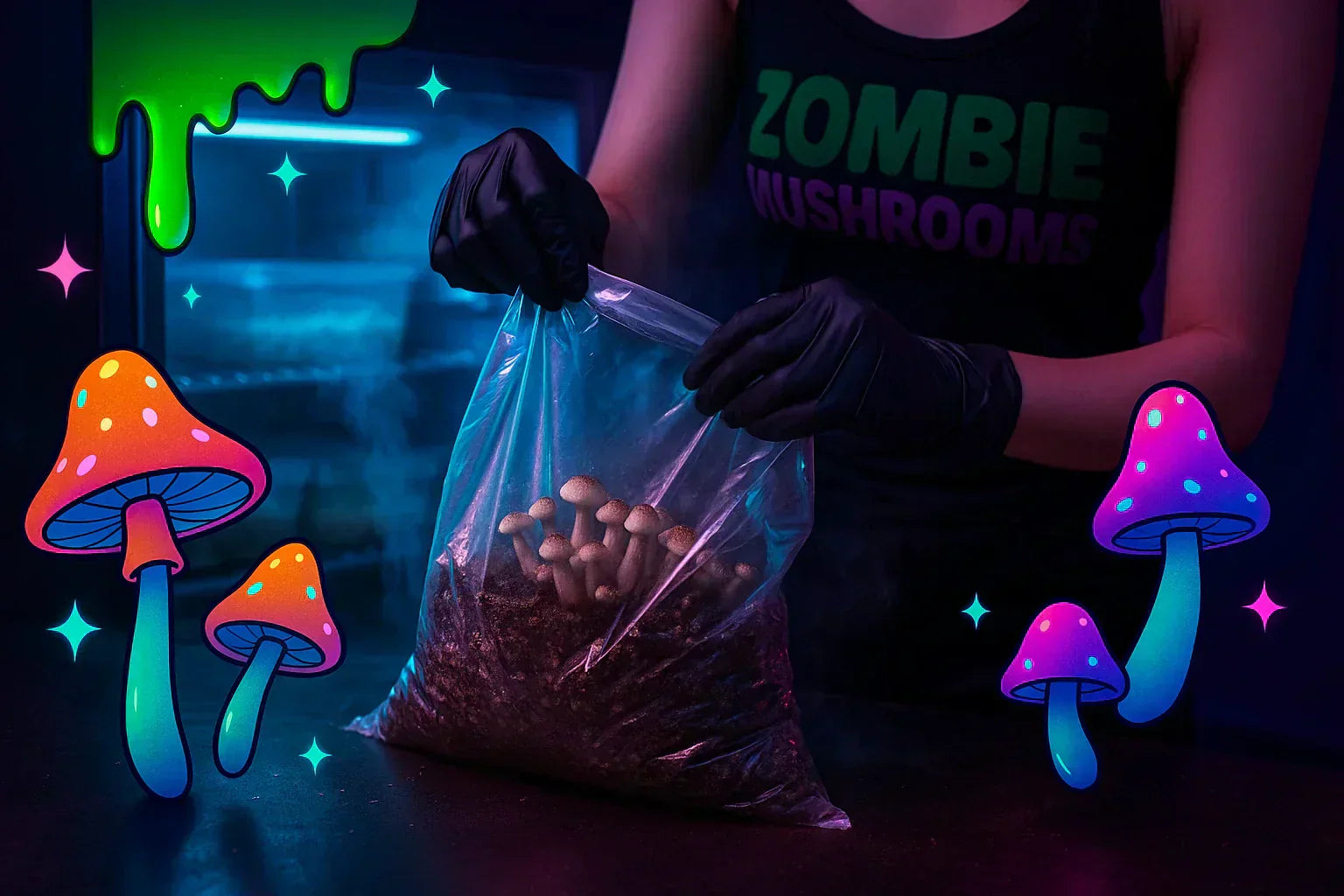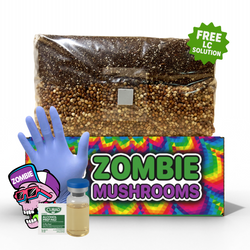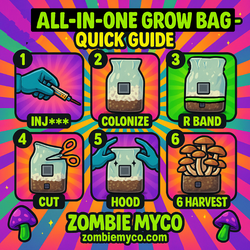⬇️ Prefer to listen instead? ⬇️
- ❄️ Cold shock tek involves a 10–15°F drop to simulate natural seasonal changes that trigger mushroom fruiting.
- 🍄 Enoki, Lion’s Mane, and Shiitake show significantly improved yields and pinning rates after proper cold shocking.
- 🧪 Studies confirm that lower temperatures activate primordia formation in several cold-weather fungi species.
- ⚠️ Cold shocking too early or using excessive cold can lead to dormancy or contamination.
- 🧰 Alternative cues like evaporation, FAE, and humidity shifts can also induce fruiting without temperature manipulation.

What Is Cold Shock Tek?
Cold Shock TEK is a temperature stimulus method that leverages a sudden drop—usually 10–15°F—to trigger more robust fruiting in certain mushrooms. When properly timed, this cold shock treatment can improve pinning, accelerate harvests, and enhance yield. For growers using Mushroom Grow Bags, maintaining the right conditions before and after cold shock becomes much easier, since grow bags help retain moisture and stabilize microclimates. This guide explores how cold shock works, which species benefit most, when to apply it without causing stress or risk, and how to use this technique effectively in your mushroom grow tent or fruiting chamber.
Not all species react this way. But many, especially those from cooler areas, respond well to this copied seasonal change. Enoki, Shiitake, Lion’s Mane, and some types of Psilocybe cubensis are among the most common mushrooms grown that might do better with this method. But like any method in mushroom growing, how well it works depends on the species, the strain, and when you do it. For best results, our mushroom grow bags make it easy to maintain the right conditions before and after cold shocking, helping ensure strong pinning and healthy fruiting.

The Science Behind Cold Shock Tek and Mushroom Fruiting
To understand why cold shock tek works, we must look at the biology of mushrooms and how they grow in nature. In the wild, mycelium—the fungus’s main body—lives most of the year inside rotting wood, soil, or plant material. Fruiting happens when outside signals show the best conditions for spores to grow and spread.
What is one of the strongest natural triggers? A sudden drop in air temperature.
When cold shocked, the mycelium reads the signal as a change to autumn-like conditions. This is important. Cooler, moister seasons are good for fungi to grow and spread their spores. The temperature drop pushes the organism from just growing to making mushrooms.
🌡️ What Happens at the Mycelial Level?
How cold makes mushrooms fruit is not fully understood. But research and what growers have seen suggest these effects:
- Primordia Formation: This is when fruiting bodies begin to form. Cold helps start this change in growth.
- Hormone-Like Compounds Activation: Stress from the environment, like cold, can turn on internal signals (such as hydrophobins and cytokinins) that change how they grow and their shape.
- Genetic Expression Changes: Genes linked to temperature signals might help them know if the environment is good for making new mushrooms.
In his important book, Paul Stamets talks about how fruiting only starts when many specific signals—like light, fresh air, humidity, surface evaporation, and a temperature drop—are all there together (Stamets, 2000).
Studies like the one by de Carvalho et al. (2010) show this. For example, Flammulina velutipes (Enoki) fruited much better in colder conditions than in steady, warmer ones.

When to Apply Cold Shock Tek: Timing Matters
Timing cold shock properly is crucial for success. Here’s how to know when your mushrooms are ready:
✅ Look for the Green Light:
- 100% Colonization – your substrate (block, jar, or grow bag) should be fully colonized with thick, white mycelium and no bare spots.
- Clean and Contaminant-Free – no green, black, pink mold; no off-smells.
- Species Sensitivity – some species like Enoki, Lion’s Mane, and Shiitake respond best after long warm colonization periods. Others (e.g., tropical strains) may barely respond, or cold shock may stress them.
Cold shocking too early or with unfinished colonization can increase risk of contamination or delayed fruiting. Wait until your substrate or Mushroom Grow Bags show full, healthy colonization before applying the cold drop.
So, if you are not sure, wait. A mature, fully colonized substrate is better at handling the cold.

Step-by-Step: How to Use Cold Shock Tek Correctly
Adding cold shock tek to your growing process is quite simple once your substrate is ready. Here’s how to do it right:
📝 Supplies Needed:
- Fully colonized substrate (block, jar, grow bag)
- A refrigerator, cold garage, or temperature-controlled chamber
- Thermometer (digital or analog)
- Airtight bag or container (optional)
🧊 Procedure:
-
Confirm readiness – ensure substrate or Mushroom Grow Bag is fully colonized with no off-color patches.
-
Select a cold location – refrigerator, cold garage, or temperature-controlled chamber set to 40-55°F (4-13°C).
-
Duration – move the substrate inside for 12-24 hours; avoid freezing or prolonged exposure which may damage mycelium or trigger dormancy.
-
Protect against dryness – place inside clean plastic or breathable container to prevent drying while cold.
-
Return to fruiting environment – after cold shock, shift back to fruiting conditions: 72-75°F (22-25°C), 90-95% relative humidity, proper fresh air exchange and indirect light.
-
Look for pins – in a few days you should observe primordia forming if conditions are optimal.

Which Mushroom Species Benefit Most from Cold Shock Tek?
Not all mushrooms benefit the same way from cold shock tek. Some species developed to read colder temperature changes as signals to fruit. Others might find it stressful or not helpful.
🌟 Top Responders to Cold Shock:
| Species | Cold Shock Response | Notes |
|---|---|---|
| Enoki | Essential | Needs low temps (~45°F/7°C) |
| Lion’s Mane | Highly effective | Improves pin set and uniformity |
| Shiitake | Very effective | Cold soaking or shocking stimulates fruiting |
| Psilocybe cubensis | Moderate | Some strains react; others don't require it |
Enoki, for example, almost does not fruit without cold. It is from cooler areas, and it grew to fruit in frosty winters. In commercial growing, people often chill Enoki cultures before fruiting to ensure it works.
On the other hand, Psilocybe cubensis is a tropical species. Some growers say certain strains get better with cold shocking. But most P. cubensis types start fruiting fine with just moisture, evaporation, and light in a well-set-up fruiting chamber.

Cold Shock Tek vs. Fruiting Chamber Environmental Cues
Experienced growers often wonder when cold shock tek is really needed. This is true especially if they are already keeping good fruiting conditions like:
- High humidity (90%+)
- Fresh air exchange (FAE)
- Light (12/12 light/dark cycle with indirect sunlight or LED)
- Warm, steady temperature (72-75°F or 22-25°C)
In these setups, mushrooms, especially types easy for beginners, often do not need more cold.
But cold shock tek can be helpful in more controlled indoor setups where there are no seasonal changes. It can be extra helpful if:
- You are growing species that like cold.
- Your grow space is too warm.
- Pins have not started even with the right conditions.
Think of it as a way to start things faster, not something you always need. If your mushrooms are not starting to fruit, this method might make them.

Common Mistakes in Cold Shock Tek
Cold shock tek is simple. But mistakes can cancel its benefits or hurt your grow:
🚫 Common Errors:
- Shocking Too Early: A grower cold-shocking a block that is not fully colonized leads to bad results and risks contamination.
- Going Too Cold: Freezing temperatures stop growth and can hurt the mycelial network.
- Prolonged Exposure: Leaving substrates cold for days instead of hours makes pinning less likely.
- Insufficient Fruiting Conditions Post-Shock: Cold shock without then giving proper humidity, light, and fresh air means no fruiting.
Use it like seasoning—the right amount can make the dish better, but too much can ruin it.

Cold Shock Tek in Action: Grower Experiences
Many growers tell stories that show how cold shock tek helps:
- 🧊 Enoki Blocks: Growers have often reported quick responses within 2–3 days of cold shocking. This is true especially after long, warm colonization times.
- 🦁 Lion’s Mane: In side-by-side tests, cold shocked Lion’s Mane blocks gave about 25% more yield than those moved straight to fruiting conditions.
- 🍄 Psilocybe cubensis: Results were mixed. Some saw early pinning, while others noticed no extra help when chambers were set up well.
What do people agree on? For cold-season or temperature-sensitive mushrooms, cold shock consistently helps. For tropical species, it may not be needed or does not work.

Alternatives to Cold Shock: Inducing Fruiting Naturally
If cold shock is not possible, or your species does not need it, there are other ways that work to start mushroom fruiting.
🌬️ Reliable Alternatives:
- Evaporation Signal: Mist the substrate often. Then, let the surface dry slightly to help pinning.
- Humidity Fluctuations: Quick wet/dry cycles make fungi aware of their surroundings.
- Light Cycles: Use a 12/12 hour light/dark cycle to signal natural seasonal changes.
- Fresh Air Exchange (FAE): This brings in more oxygen and lowers CO₂. It is a signal from how they grew over time that tells mushrooms they are above ground and safe to fruit.
Using many signals together often works best. Keep good notes, change things based on your strain, and watch how they respond.
Is Cold Shock Tek Worth It?
Cold shock tek is a useful method. But it is not always needed in every setup. It works best on species that grew up with seasonal temperature drops. For mushrooms like Enoki or Shiitake, not using cold shock can greatly cut down the chances of fruiting. But for tropical strains, controlling light, air, and humidity may give better results.
Applying cold shock correctly—after full colonization, with the right timing and temperature range—can make fruiting happen faster, increase yields, or fix pinning delays. Just remember: it is an extra method, not a replacement for a well-kept grow area.

FAQ Section
-
What is cold shock TEK in mushrooms?
Cold Shock TEK is a method where you rapidly lower the temperature of fully colonized substrate to mimic seasonal changes, encouraging mycelium to produce primordia and fruiting bodies more readily. -
Can cold shock damage mycelium or spores?
Yes, if applied incorrectly — freezing temperatures, too long exposure, or applying before full colonization can harm mycelium or invite contamination. -
Do mushrooms grow better with cold shock?
For many cold-season or temperature-sensitive species like Enoki, Lion’s Mane, and Shiitake, cold shock often leads to faster pinning, improved growth, and sometimes higher yields. Tropical species may not benefit as much. -
When is the best time to apply cold shock?
After the substrate or Mushroom Grow Bag is 100% colonized and free of contaminants, before any visible pins have appeared. -
Is cold shock necessary if I already have proper humidity, light, and fresh air exchange?
Not always. If your fruiting chamber or grow tent already maintains ideal conditions, cold shock may offer marginal gains or be unnecessary. It’s most useful when environmental cues are lacking.
Cold Shock Tek & Zombie Mushrooms Grow Kits
Zombie Mushrooms kits make growing easier for beginners and experienced hobbyists. Depending on the species you pick, cold shock might be suggested.
For cold-loving mushrooms like Lion’s Mane, Enoki, or Shiitake, expect cold shock tek as part of the instructions for after colonization. Kits often include a timeline and exact steps.
❄️ General Cold Shock Process for Kits:
- Wait to see that colonization is complete.
- Cold shock for 12–24 hours in a refrigerator.
- Move to your fruiting chamber. Make sure it has good moisture and airflow.
- Watch closely for the next few days to see pins grow.
Zombie Mushrooms made its kits to lower differences. So, following directions closely usually means you do not have to guess. Use cold shock as a way to improve results—not a required trick.
Ready to grow your best mushrooms yet? Know your species, respect your timing, and use tools like cold shock tek to copy nature's cleverness in your indoor setup. Mushrooms do well when we match their life cycles—even if that means giving them a little brrr now and then.
Citations
- Stamets, P. (2000). Growing Gourmet and Medicinal Mushrooms. Berkeley: Ten Speed Press.
- de Carvalho, M. D., de Souza, C. D., & Bononi, V. L. R. (2010). Effect of temperature on mycelial growth of edible mushrooms. Brazilian Journal of Microbiology, 41(2), 408–412. https://doi.org/10.1590/S1517-83822010000200023
- Sanchez, C. (2010). Cultivation of Pleurotus ostreatus and other edible mushrooms. Applied Microbiology and Biotechnology, 85(5), 1321–1337. https://doi.org/10.1007/s00253-009-2343-7



